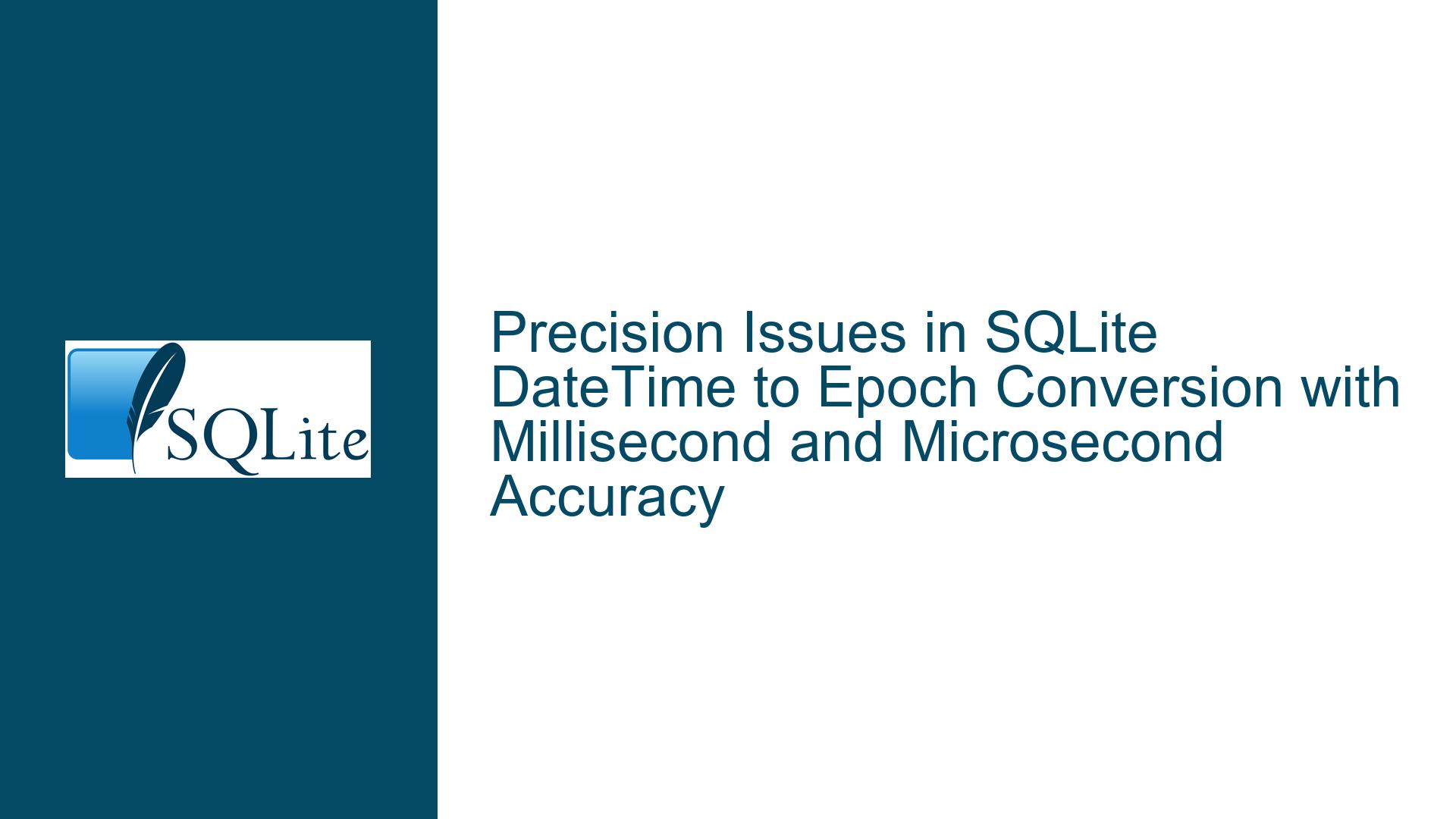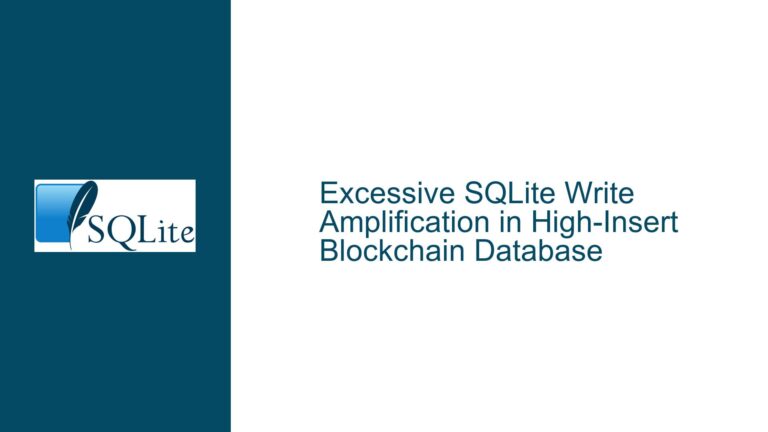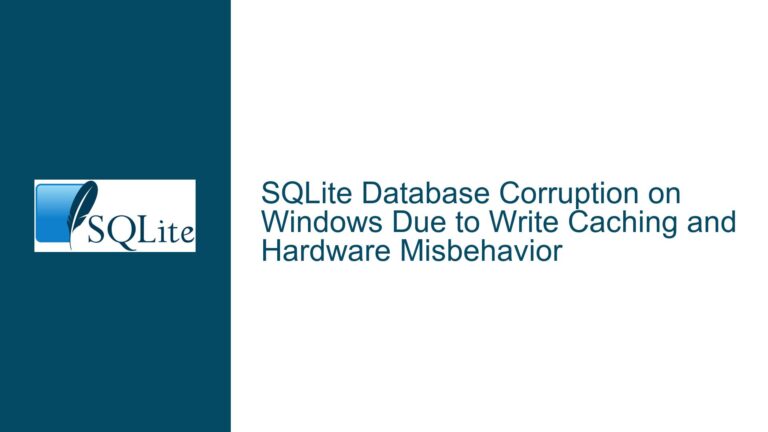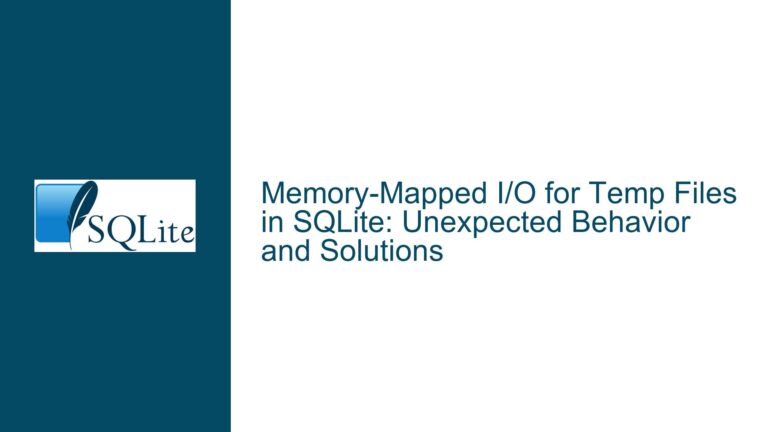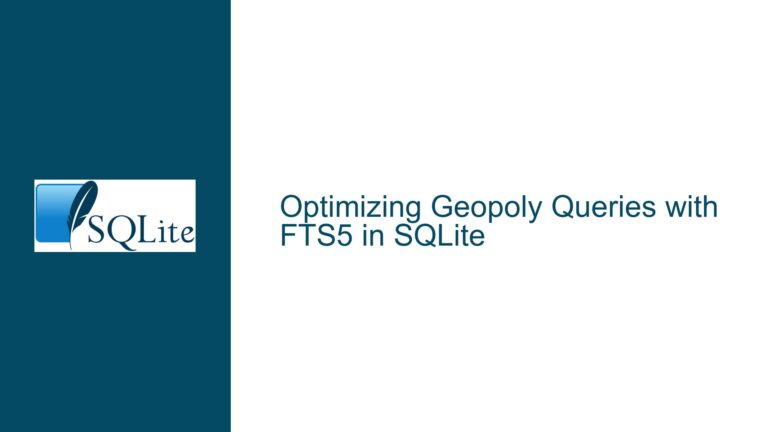Precision Issues in SQLite DateTime to Epoch Conversion with Millisecond and Microsecond Accuracy
DateTime to Epoch Conversion with Millisecond Precision in SQLite
Converting a datetime string to the number of seconds since the Unix Epoch (January 1, 1970) with millisecond precision is a common requirement in database operations. SQLite provides several built-in functions to handle datetime conversions, but achieving millisecond precision can be tricky due to the way SQLite internally stores and processes datetime values.
The most straightforward approach involves using the strftime function to extract the seconds since the Epoch and then adding the fractional seconds to achieve millisecond precision. For example, the following query converts the datetime string '2016-06-13T09:36:34.123Z' to the corresponding Unix timestamp with millisecond precision:
SELECT
CAST(strftime('%s', '2016-06-13T09:36:34.123Z') AS REAL) +
(strftime('%f', '2016-06-13T09:36:34.123Z') -
CAST(strftime('%S', '2016-06-13T09:36:34.123Z') AS REAL);
This query works by first extracting the seconds since the Epoch using strftime('%s', ...), then adding the fractional seconds using strftime('%f', ...), and finally subtracting the integer seconds to ensure that only the fractional part is added. While this approach works, it is somewhat cumbersome and involves multiple calls to strftime, which can be inefficient.
A more elegant solution leverages the julianday function, which returns the Julian Day Number (JDN) as a floating-point number. The JDN can be converted to seconds since the Unix Epoch by subtracting the JDN for the Unix Epoch (2440587.5) and multiplying by the number of seconds in a day (86400.0):
SELECT (julianday('2016-06-13T09:36:34.123Z') - 2440587.5) * 86400.0;
This method is more efficient because it avoids multiple calls to strftime and directly computes the desired value using a single function call. The julianday function is internally optimized for datetime calculations and provides millisecond precision across the entire range of valid SQLite datetimes.
Challenges with Timezone Suffixes and Microsecond Precision
While the julianday method works well for datetime strings in the YYYY-MM-DDThh:mm:ss.sssZ format, it encounters issues when dealing with timezone suffixes. SQLite’s datetime functions support timezone indicators in the form of [+-]HH:MM or Z, but the presence of these suffixes can cause the julianday function to return NULL if the format is not strictly adhered to. For example, the following query will return NULL due to the incorrect timezone suffix format:
SELECT (julianday('2014-09-09T15:33:25Z+01:00') - 2440587.5) * 86400.0;
To handle timezone suffixes correctly, the datetime string must either use the Z indicator or the [+-]HH:MM format. For example, the following query will work correctly:
SELECT (julianday('2014-09-09T15:33:25+01:00') - 2440587.5) * 86400.0;
Another challenge arises when microsecond precision is required. SQLite’s internal datetime representation stores values with millisecond precision, which means that any attempt to achieve microsecond precision will be limited by the underlying storage format. For example, consider the following table and queries:
CREATE TABLE t(s TEXT, f REAL);
INSERT INTO t(s) VALUES ('2016-06-13T09:36:34Z');
INSERT INTO t(s) VALUES ('2016-06-13T09:36:34.123Z');
INSERT INTO t(s) VALUES ('2016-06-13T09:36:34.123456Z');
UPDATE t SET f = (julianday(s) - 2440587.5) * 86400.0;
When querying the table, the results show that the julianday function introduces small inaccuracies when dealing with microsecond precision:
SELECT s, printf('%.6f', f) FROM t;
The output reveals that the computed values deviate slightly from the expected results, with discrepancies of up to 1005 microseconds. This behavior is due to the limitations of SQLite’s internal datetime storage and the floating-point arithmetic used in the conversion process.
Achieving Microsecond Precision with Custom Functions and Integer Storage
To achieve microsecond precision, one approach is to store the datetime values as integers representing the number of microseconds since the Unix Epoch. This avoids the limitations of floating-point arithmetic and ensures full 64-bit precision. However, SQLite’s built-in datetime functions do not natively support microsecond precision, so custom functions or external libraries may be required.
For example, a custom SQLite function could be implemented to convert a datetime string to microseconds since the Epoch:
static void _UnixTimeMicroseconds(sqlite3_context *context, int argc, sqlite3_value **argv) {
DateTime x;
if (isDate(context, argc, argv, &x) == 0) {
sqlite3_result_int64(context, (x.iJD - 210866760000000ll) * 1000);
}
}
This function calculates the number of microseconds since the Unix Epoch by multiplying the internal millisecond value by 1000. The result is returned as a 64-bit integer, ensuring full precision.
Another approach is to use an external library or extension to handle datetime conversions with microsecond precision. For example, the xCurrentTimeInt64 method of the SQLite VFS (Virtual File System) can be used to obtain the current time with nanosecond precision. However, this method is volatile and may not be suitable for all use cases.
In summary, achieving millisecond and microsecond precision in SQLite datetime conversions requires careful consideration of the underlying storage format and arithmetic limitations. The julianday function provides a robust solution for millisecond precision, while custom functions or external libraries may be necessary for microsecond precision. Timezone suffixes must be handled correctly to avoid NULL results, and floating-point arithmetic should be used with caution to minimize inaccuracies.
| Datetime String | Computed Value (Seconds since Epoch) | Precision Deviation |
|---|---|---|
2016-06-13T09:36:34Z | 1465810594.000009 | +9 microseconds |
2016-06-13T09:36:34.123Z | 1465810594.121995 | -5 microseconds |
2016-06-13T09:36:34.123456Z | 1465810594.123001 | +1 microsecond |
This table illustrates the precision deviations observed when using the julianday function to convert datetime strings to seconds since the Unix Epoch. The deviations are small but significant for applications requiring high precision.
